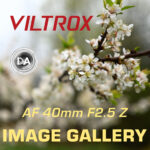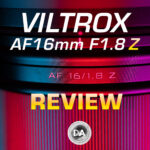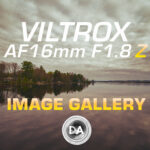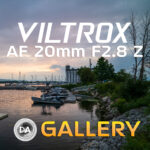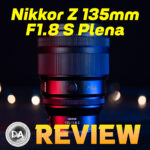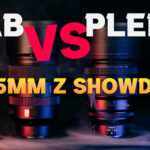
Viltrox AF 40mm F2.5 Z Mount Review
Last year Viltrox released a lens that surprised me – the AF 20mm F2.8. I didn’t expect much from it, as it was very inexpensive (just $150!), which is definitely not much for a full frame wide angle prime lens. I was very pleasantly surprised by the performance, however, and gave it a positive review. Viltrox followed that up with another very competent lens that was similar in size and design – the AF 56mm F1.7 for Fuji X-mount (APS-C). It is a very sharp little lens that manages to keep up with Fuji’s massive 40MP APS-C sensor. By this point I started to see the pattern: Viltrox recognizes that there are those interested in the larger, high performing lenses (like the AF 16mm F1.8 Z that I just reviewed), but there is also a sizable market who are very interested in compact, lightweight lenses for travel or keeping their gear light. It is in that vein that they released their most recent lens in this series – the Viltrox AF 40mm F2.5 Z. The 40mm F2.5Z offers a “normal” angle of view on full frame cameras and a slightly faster maximum aperture than equivalent zooms covering this focal length. But probably most attractive to potential buyers will be the budget price of just $158 USD. But does the performance of the lens make it a worthwhile alternative to a well regarded lens like the Nikkor Z 40mm F2? Find out my thoughts by watching the video review below…or just keep reading.
Follow Me @ YouTube | Patreon | Instagram | Facebook | DA Merchandise | Flickr | 500px | X
__________________________________________________________________________________________________
Thanks to Viltrox for sending me a review copy of this lens. As always, this is a completely independent review. All opinions and conclusions are my own. *The tests and most of the photos that I share as a part of my review cycle have been done with the 45MP Nikon Z8, which I reviewed here.
__________________________________________________________________________________________________
As noted, this lens will have a direct competitor in the form of Nikon’s own 40mm F2. I haven’t yet tested that lens, though I do have one ordered and hope to receive it in time to reference somewhat in this review. The full retail price of the Nikkor lens is $299 USD (nearly double that of the Viltrox), though it currently is available at right under $230, which is close enough in price to make things interesting. The Nikkor lens obviously has the advantage of being a first party lens and having a wider maximum aperture (F2 is 2/3rds of a stop brighter than F2.5), but surprisingly it is the Viltrox that has the build advantage, as it has a metal lens mount (the Nikkor uses plastic) and includes a lens hood.

This particular Viltrox series is quite basic in design (no external switches or controls), but it actually performs quite well where it matters…particularly in image sharpness.

So is this a lens that you should consider? Keep reading to find out.
Build and Handling
As noted, the build here is basic, but considering that the more expensive Nikkor lens is even more basic, we won’t fault Viltrox here. At least everything is built around a metal lens mount.

There’s also the ubiquitous Viltrox feature there – a USB-C port to enable firmware updates.

This has been a great move by Viltrox, as it has enabled them to keep their lenses current and to allow for some improvement to function (like autofocus). The ability to easily update firmware assures that lenses will stay compatible in the future, which is obviously very important.
The primary objective for Viltrox is to keep things small and lightweight. And in that metric they have been very successful. The 40mm F2.5Z is 68mm (2.7″) in diameter and right under 60mm (2.2″) in length. It has a common 52mm front filter thread and weighs just 180g (6.3oz). The Nikkor is shorter (10mm) and very slightly lighter (10g).

This will obviously be a great pairing for smaller, more compact Nikon cameras. The size is somewhat wasted on my mammoth Z8 body where the grips sticks out nearly as much as the lens.

The size is virtually identical to the 20mm F2.8. The two lens hoods are identical, and I suspect that if one were to compare lenses for identical mounts they would be identical.

The Nikon Z mount is considerably wider than Sony’s E-mount, so you can see that the bottom section of the lens flares out to accommodate the wider lens mount on the Z-mount lens, while the E-mount version tapers in in that section instead.

If we look inside, we can see that there are seven aperture blades that aren’t particularly rounded. You will see that aperture shape at times.

The only thing on the lens barrel is the manual focus ring, but fortunately that is pretty well executed. It’s nice and wide, has good feel, and offers good manual focus precision without visible steps. Nothing really to complain about there, particularly on such an inexpensive lens.

There is a very slim lens hood included that bayonets into place but without as much precision and confidence as I would like. It doesn’t feel like it really “clicks” into place and locks in the right position. A lens pouch is also included. The pouch doesn’t add a lot of protection value, but, like the hood, at least it is included. There are many more expensive lenses that include neither a pouch or a hood.

Viltrox lenses have traditionally had a fairly poor minimum focus distance and maximum magnification standard, but fortunately that is starting to change. The Viltrox AF 40mm F2.5Z has a minimum focus distance of 34cm and a respectable maximum magnification of 0.14x. That does lag behind the Nikkor 40mm F2 and its 0.17x magnification, but at least it is enough to be useful.

Up close performance is only okay at F2.5. You’ll need to stop down a bit to get maximum sharpness and contrast.
This inexpensive lens does not have weather sealing, though that’s obviously not expected in such an inexpensive lens. This is a pretty basic lens, but it doesn’t feel “cheap” or “plasticky”. It is primarily made of plastics, but they are good quality, and the lens has a tough, durable feel that seems like it will hold up well for the long haul. I’ve traveled a fair bit with the 20mm F2.8 that is the virtual twin to this lens, and I’ve had zero problems with it. I expect the same here.
Autofocus and Video
The Viltrox AF 40mm F2.5Z utilizes a stepping focus motor (STM) that works well, though it isn’t blazingly fast. Focus changes for most things are quick enough for you to forget about autofocus, but every now and then when a major focus change is required you are reminded that this is an autofocus motor that could use a little extra thrust. Fortunately accuracy isn’t a problem; I got consistently well focused results.

I did sometimes run into the issue autofocus was reluctant to grab a close foreground object, though that seemed to be a common occurrence with all three lenses I was testing on Nikon, so it may be more of an autofocus system issue than something specific to this lens.
I love 40mm for “everyday photography”, like capturing family events, as it is a focal length that works well in the typical room, allowing you enough room to capture the scene in context but with a normal, unexaggerated perspective. The 40mm F2.5Z worked well for these moments, delivering accurately focused results and locking onto the eyes consistently.

Cats love boxes…so Ferrari had to try to climb into the box that my wife’s present came in even if he didn’t fit very well. Focus locked on the eye!

There is a faint clicking sound if you put your ear right next to the lens barrel, but if I held the camera at chest level and racked focus here and there, I couldn’t hear anything.
I had good results during a portrait session. Focus locked consistently on the eyes and delivered very nice looking results at F2.5:


I was able to nail focus on Ferrari moving towards me at a slow but steady pace, which isn’t always easy for inexpensive lenses.

Switching to video found focus pulls smooth and nicely damped, but not speedy. You could turn the autofocus speed up in camera for focus pulls if desired. What I didn’t see was any hunting or pulsing. Autofocus was solid in terms of confidence. There’s just enough focus breathing for me to notice it, though it isn’t bad.
My “hand test” where I alternately block the camera’s view of my face with my hand and then remove it didn’t go well. The lens wasn’t reactive enough, and so it often hadn’t really switched to focus on my hand by the time I moved it again.
I found a similar trend when naturally moving from one subject to another during video capture. Autofocus seemed to stay locked on the current subject longer than what I would like even as I intentionally panned the camera away from it, and then the transition to the new subject would be relatively quick. It’s not really a very cinematic feel.
So I give good marks for confidence on the subject and not being jittery, but poor remarks for the reactiveness of the focus motor when needing to move to a new subject. The bottom line is that the focus system for both stills and video is smooth and confident, but not really fast. It’s fast enough for most situations, but there might be a few situations where you find yourself wanting more.
Image Quality Breakdown
The optical formula is 10 elements in 6 groups, with five of those elements being special elements (including 1 ED, 3 HR, and 1 aspherical element). The MTF chart shows a good (not great) center performance, a dip right past mid-frame, and then a slight recovery in the corners.

I started reviewing Viltrox lenses right at the beginning, and at first I was less than impressed by the optical glass when it came to colors. But Viltrox has really improved their optical glass in the past two years, and now I find colors both neutral and natural looking.

There is a slight amount of LoCA (longitudinal chromatic aberrations), but nothing too severe.

I can see a bit of fringing after the plane of focus on these plum blossoms, but there’s nothing that will actually be disruptive.


There’s also a minor but manageable amount of LaCA (lateral chromatic aberrations) that typically show up along the edges of the frame with high contrast transition points. Here we can see at F8 there there are minor amounts of fringing.

Not a perfect performance, but well controlled enough to be a non-factor for most all real world uses.
If we move on to vignette and distortion we find very little distortion but a stronger amount of vignette. You could easily leave the distortion uncorrected, and I found that an extremely minor +1 was all I needed to dial in to correct the tiny amount of barrel distortion. Vignette was a little heavier, however, requiring a +72 (between 2-3 stops) to correct.

We’ll move on to inspecting our test chart. This test has been done on a 45MP Nikon Z8 sensor. I use a high end tripod and two second camera delay to ensure vibration doesn’t affect images. Here’s a look at the test chart that we will examine at high magnification:

If we take a look at crops (at about 180%) at F2.5 from the center, mid-frame, and lower right corner, we find that center performance is good, but the mid-frame and the corners stand out as being sharper than most budget lenses.



That was reflected in my real world results, which I consistently found pleasingly sharp and with nice amounts of contrast.


Stopping down the 1/3rd stop to F2.8 doesn’t make any kind of radical difference in sharpness or contrast, but it does reduce vignette a bit and increases contrast just enough that the overall looks brighter and slightly snappier.

A more obvious improvement is found from F2.8 to F4, where image quality is now very sharp all across the frame…including the far corners.

There’s a bit more on tap by F5.6, and that makes for very nice landscape results that are richly detailed, have good contrast, and exhibit nice color as well.

Expect the typical diffraction pattern on high resolution cameras where the image is a little softer by F11 and softer still at the minimum aperture of F16:

This is an extremely sharp lens for the money. It handles the 45MP of my Z8 pretty effortlessly. I zoomed in to 100% magnification on many images and liked what I saw.


Bokeh is a subjective measurement, and I personally find the bokeh from the 40mm F2.5Z a bit of a mixed bag. Probably the most controversial element will be the outlining around specular highlights (sometimes called “bubble bokeh”). Some people love it, some people hate it. Here’s an example:

You can also see that the geometry gets a bit squeezed near the edges of the frame, losing the circular shape.
I don’t mind the look of the outlining of the specular highlights in the image above, but in other situations I found that it created some busyness.

Get a little closer, however, and that bokeh gets softer looking and quite nice.

This shot of a chain-link fence shows both the good and the bad:

Again, this is a budget optic, and so the bokeh really isn’t bad for the price, but neither is it incredible. I’m more impressed with the lens’ sharpness than its bokeh.
Flare resistance is a bit of a mixed bag. On the plus side, I didn’t see any egregious ghosting patterns either at wide or small apertures.



But you will get some flashing effects when the sun or bright light source is either at the edge of the frame or right out of frame (you can see a bit of this in the first image above). You can see the effect in this image here, though I’ve used it to artistic effect and like the look here.

The Viltrox AF 40mm F2.5Z should serve as a nice street lens, general purpose lens, and even a budget portrait lens for when you want a little more of the environment in the shot.

A lens with a maximum aperture of F2.5 is not incredibly bright, but when you consider that a typical kit lens is going to be either F5.6 or F6.3 by 40mm, that means this inexpensive little prime will be giving 200-300% more light gathering potential, making it a much more attractive low light performer than such lenses.

Overall, I would say there is far more good than bad here. You can check out more photos by visiting the image gallery here.
Conclusion
I love that Nikon Z-mount has now opened up to third party development, as lenses like this Viltrox AF 40mm F2.5Z give some options that simply would not have otherwise existed. Sometimes after having saved a long time to buy a new camera, there isn’t much left over to spend on lenses, and being able to get a quality lens for just $160 USD is fantastic.

The 40mm F2.5Z has a lot of strengths and a very decent (if simple) build for the money. Autofocus isn’t particularly snappy, but it is quiet and accurate. And optically the lens has a number of strengths and no real fatal weaknesses. I suspect that no one would know that you are shooting with inexpensive glass from the images alone.

For the money, this is a great little performer, and the light weight makes it an easy lens to throw into the bag for an alternate perspective or aperture value. I love lenses like this for travel, though admittedly among the Z8’s many strengths, travel is not really one of them. This lens is a more natural pairing for a camera like the ZF…but then, so is Nikon’s own Nikkor 40mm F2. It is unusual for Viltrox to really have much headwind from a first party lens with any of their offerings, and at the MSRP of $299, there is still plenty of separation between the two lenses. But with the Nikkor currently discounted by $70, the price difference becomes more negligible, and that makes the buying decision a little harder. Sometimes having options does that…
Pros:
- Compact and lightweight
- Amazing price
- Comes with hood and bag
- Build feels tough rather than plasticky
- USB port for firmware updates
- Autofocus is quiet and accurate
- Excellent sharpness
- Colors look good
- Low distortion
- No fatal optical flaw
- Amazing price to performance ratio
Cons:
- Vignette a little heavy
- Lens hood doesn’t lock in place well
- Bokeh can get a little busy
_________________________________________________________________________
GEAR USED:
Purchase the Viltrox AF 40mm F2.5 Z @ Viltrox | B&H | Nuzira | Adorama | Amazon | Amazon Canada | Amazon UK | Amazon Germany
_______________________________________________________________
Purchase the Nikon Z8 @ B&H Photo | Adorama | Amazon | Camera Canada | Amazon Canada | Amazon UK | Amazon Germany
_________________________________________________________________
Want to support this channel? Use these affiliate links to shop at: B&H Photo | Amazon | Adorama | Camera Canada | Amazon Canada | Amazon UK | Ebay | Make a donation via Paypal
Buy DA Merchandise https://bit.ly/TWIMerch

Keywords: Viltrox, Viltrox AF, Viltrox 40mm, Normal, Full Frame, F2.5, f/2.5, STM, Viltrox AF 40mm F2.5 Z, Viltrox 40mm Review, Viltrox AF 40mm F2.5 Z Review, LCD Screen, Nikon, Nikon Z8, Z, Z-mount, Z8, Review, mirrorless, Full Frame, Sports, Tracking, Dustin Abbott, Real World, Comparison, Handling, Focus, Portraits, Resolution, High ISO, Image Quality, Sample Images, Photography, 45MP, #letthelightin, #DA, #NIKON, #Z8, #NIKONZ8

